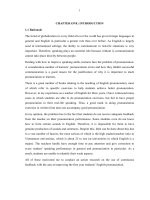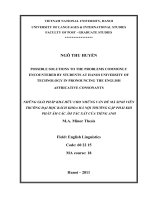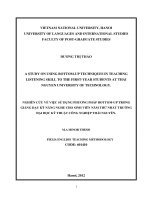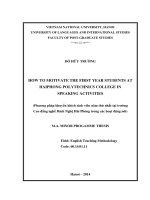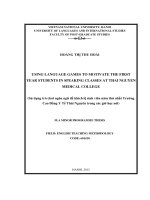Ways to motivate the first year non-English majors at Ha Noi University of Technology in Learning English Speaking Skill
Bạn đang xem bản rút gọn của tài liệu. Xem và tải ngay bản đầy đủ của tài liệu tại đây (206.42 KB, 8 trang )
Ways to motivate the first year non-English
majors at Ha Noi University of Technology in
Learning English Speaking Skill
Nguyễn Thị Phương
Trường Đại học Ngoại ngữ
Luận văn ThS. Chuyên ngành: Theory and methodology of English teaching
Mã số: 60 14 10
Người hướng dẫn: M.A. Nguyễn Huyền Minh
Năm bảo vệ: 2011
Abstract: This study is an effort to investigate ways to motivate the first year non-
English majors in learning English speaking skill at Ha Noi University of Technology.
The main purposes of the study are to find out: types of motivation possessed by the first
year non-English majors at Ha Noi University of Technology, factors affecting students’
motivation in learning English speaking skill, speaking motivational activities and
techniques applied by teachers and students’ opinions about them and then give some
recommendations for teachers to encourage students to speak English. The study is
composed of three main parts. Part I, the introduction, reveals the rationale, aims,
research questions, scope, design, methods of the research. Part II is divided into three
chapters. Chapter 1 reviews theoretical background of motivation and speaking. Chapter
2 gives the instrumentation, data collection and data analysis. Chapter 3 sums up some
major findings and discussion, and then presents recommendations to the English
teachers. Part III, the conclusion, points out what the researcher have done and what she
have not done and give some suggestions for further study.
Keywords: Tiếng Anh; Phương pháp giảng dạy; Kỹ năng nói
Content
PART I: INTRODUCTION
1. Rationale
It is a truth that English has become an international language. It is widely used in many fields of
our life such as business, trade, banking, science, technology, aviation, diplomacy, etc. Because
of the wide spread of globalization and the rapid development of information technology, the
demand for English has become more and more urgent in our life.
As a result, there has been an increase in the number of people desiring to learn and master
English with the hope of finding a good job, keeping up with the latest technology in the world.
In Vietnam, English is taught not only at schools or colleges/ universities but also at many
foreign language centers. However, not all English learners succeed in learning English. Some
people succeed while others fail because learning a foreign language is not similar to the study of
other subjects. Second language learning is affected by many factors such as motivation, learning
environment, learning conditions, methods of teaching, attitude, age, etc. Among these factors,
motivation is considered as a key factor affecting success or failure of a second language learner.
Therefore, exploring ways to motivate learners is extremely important for teachers. There have
been many researchers investigating what factors have effects on foreign language learning or
types of motivation; little has been discussed about what ways should be used to motivate
learners.
In many Universities in general and in Ha Noi University of Science and Technology in
particular, teachers have to struggle with large class, prescribed books, limited time for formal
instruction and students with low English level, etc. Many teachers fail to try out communicative
activities because of these factors. The inhomogeneity of the students’ English proficiency is also
a barrier to the success in carrying out
communicative tasks. As a result, a large number of students cannot use English to
communicative in real life. This actually drives the researcher to her study namely “Ways to
Motivate the First Year Non – English Majors at Ha Noi University of Technology in
Learning Speaking Skill” in order to study the current situation of teaching and learning the
speaking skill, the activities, methods and techniques used and then give recommendations to
motivate the students to speak English.
2. Aims of the study
The study is aimed at:
Investigating methods, activities and techniques used by the teachers to motivate the
students in speaking skill.
Recommending several activities and techniques to motivate the students to speak
English.
3. Research questions
In order to gain the aims mentioned above, the following questions were asked in the study:
1. What are the activities and techniques used by the teachers to motivate students in learning
English skill?
2. Which activities and techniques are considered as effective tools in motivating students to
speak English?
4. Scope of the study
The study will be carried out within the following scope:
As we know, motivation is a broad topic that cannot be thoroughly discussed in this paper. So in
this study, the researcher will discuss one specific aspect: ways to motivate students in speaking
skill. The subjects for this study are 99 first year non-English majors at Ha Noi University of
Science and Technology in the hope that the results of this study are representative to all
Vietnamese non – English majors.
5. Methods of the study
The study was planned to use a variety of methods to obtain its aims as follows:
A questionnaire was distributed to 14 teachers who are now teaching or have taught speaking
skill to first year non – English majors to collect their opinions on motivation, examine speaking
motivational activities, techniques used by teachers to motivate students to speak and explore
their attitudes towards students who are reluctant to speak and keep making mistakes as well as
their ways for error correction.
Another questionnaire was distributed to 99 first year non-English majors to gather their
opinions on speaking skill, factors affecting their motivation to speak English in class, and what
activities and techniques used by the teachers.
An interview was conducted with 8 students randomly selected from the survey population to
explore further issues of interest.
An observation was conducted at the two speaking classes to investigate the students’ responses
and attitudes on the speaking lessons as well as speaking motivational activities and techniques
used by the teachers to motivate students to speak.
6. Design of the study
This paper consists of three main parts.
PART I. INTRODUCTION presents the rationale, the aims, the research questions, the scope,
the method and the design of the study.
PART II. DEVELOPMENT is composed of four following chapters:
CHAPTER ONE: Literature review presents the concepts relevant to the study such as
motivation, kinds of motivation, the importance of motivation in second language learning,
factors affection motivation in second language learning, the nature of speaking: definitions of
speaking, the importance of speaking, phases to teaching speaking, key issues in teaching
speaking, speaking motivational activities and techniques to motivate students to speak.
CHAPTER TWO: Methodology presents a general view of the current situation of the learning
and teaching the speaking skill, subjects of the study and research instruments.
CHAPTER THREE: Data Presentation and Analysis
CHAPTER FOUR: Discussions and Recommendations
PART III. CONCLUSION
References
Aiming Z., Aimin L. (2006), “Learners’ Motivation and the Implications for
Classroom Teaching”, Canadian Social Science, Vol.2, No.1, March 2006, pp. 60-62.
Retrieved on 10
th
August 2011 from website:
Bailey K.M. (2005), Practical English Language Teaching: Speaking, McGraw-Hill
Companies, Inc.
Brown H.D. (1994), Teaching by Principles: An Interactive Approach to Language
Pedagogy, Prentice Hall Regents Prentice – Hall, Inc.
Brown H.D. (1981), Affective Factors in Second Language Learning, Alatis J.E. et al.
Eds, The Second Language Classroom: Directions for the 1980’s, OUP, Oxford.
Brown H.D. (2007), Principles of Language Learning and Teaching (5
th
edition),
Pearson Education, Inc.
Burns A., Joyce H. (1997), Focus on Speaking, Sydney: National Center for English Language
Teaching and Research.
Byrne D. (1986), Teaching Oral English, Longman Group UK Limited.
Byrne D. (1991), Techniques for Classroom Interaction, London: Longman
Carter R., McCarthy M. (1995), “Grammar and Spoken Language”, Applied
Linguistics, 16 (2), 141-158.
Cashin W. E. (1979), Motivating Students, Idea Paper, no. 1. Manhattan: Center for
Faculty Evaluation and Development in Higher Education, Kansas State University.
Cohen A. (1996), “Developing the Ability to Perform Speech Acts”, Studies in Second
Language Acquisition, 18 (2), 253-267.
Davies P. (2000), Success in English Teaching, Oxford University Press.
Dornyei Z. (2001), Motivational Strategies in the Language Classroom, Cambridge:
Cambridge University Press.
Dornyei Z. (2001), Teaching and Researching Motivation, Pearson Education Limited.
Fiore N. (1985), On Not Doing a Student's Homework, Chemistry TA Handbook, Berkeley:
Chemistry Department, University of California.
Gardner R.C. (1985), Social Psychology and Second Language Learning: The Role of
Attitudes and Motivation, Edward Arnold, London.
Grass, M.S & Selinker, L (2008), Second Language Acquisition: An Introductory
Course (Third edition). Taylor & Francis Group.
Guilloteaux J.M., Dornyei Z. (2008), “Motivating Language Learners: A Classroom-
Oriented Investigation of the Effects of Motivational Strategies on Student Motivation”,
TESOL QUARTERLY Vol.42, No. 1, p. 76.
Harmer J. (1983), The Practice of English Language Teaching, London: Longman.
Johnson D.M. (1992), Approaches to Research in Second Language Learning, N.Y.:
Longman.
Krashen S. (1985), The Input Hypothesis: Issues and Implications, New York:
Longman.
Li C. (2009), “A Research on Second Language Acquisition and College English
Teaching. English Language Teaching”, Vol.2, No.4, December 2009, p.58 Retrieved on
7
th
July, 2011 from website:
Lightbown P.M., Spada. N. (1999), How Languages are Learnt, Oxford: Oxford
University Press.
Lucas A. F. (1990), Using Psychological Models to Understand Student Motivation, In
Svinicki M. D. (ed.), The Changing Face of College Teaching, New Directions for
Teaching and Learning, no. 42. San Francisco: Jossey-Bass.
Nation I.S.P. (2000), Creating, Adapting and Using Language Teaching Techniques,
English Language Institute Occasional Publication No. 20. Victoria University of
Wellington.
Nation P. (1997), “L1 and L2 Use in the Classroom: a Systematic Approach”, TESL
Reporter, 30(2), pp. 19-27.
Oxford R.L. (1999), Anxiety and the Language Learner: New Insights, In Arnold J.
(Ed.), Affect in Language Learning (pp. 58-67), Cambridge: Cambridge University Press.
Reece I., Walker. S. (1997), Teaching, Training and Learning. A Practical Guide
(Third Ed.), Great Britain: Business Education Publishers Limited.
Shumin K. (1997), “Factors to Consider: Developing Adult EFL Students’ Speaking
Abilities”, English Teaching Forum, 35, 3, pp. 8–13.
Wang B. (2009), “Motivation and Language Learning”, Asian Social Science, Vo.5,
No.1, January 2009, p.98. Retrieved on 7
th
July 2011 from website:
Tsui A.B.M. (1996), Reticence and Anxiety in Second Language Learning, In K.M.
Young D.J. (1991), “Creating a Low-anxiety Classroom Environment: What Does
Language Anxiety Research Suggest?” The Modern Language Journal, 75(iv),
426-439.
Wang H.Y. (2010), “Using Communicative Language Games in Teaching and
Learning English in Taiwanese Promary Schools”, Journal of Engineering Technology
and Education, Vol. 7, No. 1, pp. 126-142. Retrieved on 7
th
July 2011 from website:
Other websites:
Speaking.html
/>dout.pdf

